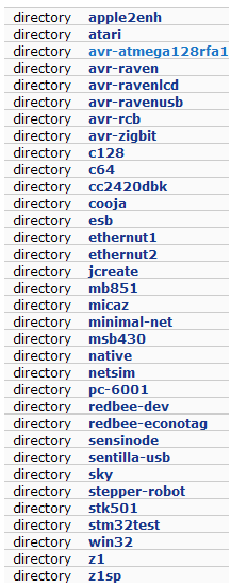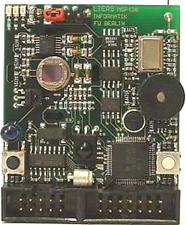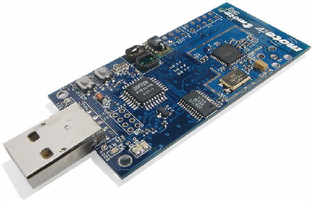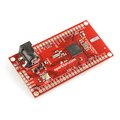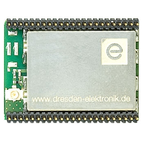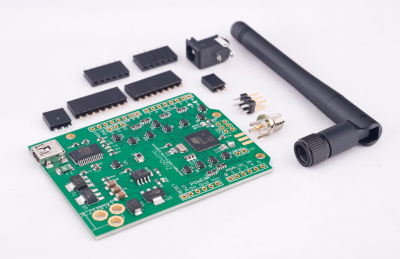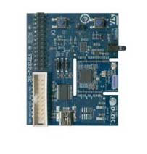Contiki
From emboxit
Contents
Documentation
- Contiki WIKI started in 2011
- Official Contiki is here for more than 7 years. Much more info than WIKI
- About Contiki most interesting introduction to Contiki
Overview
- Free and Open Source
- Straight 'C', Non-Blocking Protothreads.
- Cooja network simulator
- MSPsim
- GUI
- Developers Forum
- Over Radio Programming
- Well documented
- LPC2103
- CC2430
- VMWARE
- Contiki wiki goto Tutorials and Start-Guides
- Contiki home
Platforms
- The best way to know what platforms are supported is to install Contiki and then get latest source from github
- Or, Browse the contiki source code at http://contiki.git.sourceforge.net/git/gitweb.cgi?p=contiki/contiki;a=tree
- Or Contiki Doxygen on platforms
ESB
- The ESB Embedded Sensor Board GOOD INSTALLATION GUIDE FOR CONTIKI DEVELOPMENT
- RFM TR1001 [Mouser 11EU BGA module]
- RFM TR1001 [Mouser 11EU BGA module]
Tmote-Sky
- Tmote-Sky datasheet
The Tmote Sky module is programmed through the onboard USB connector. A modified version of the MSP430 Bootstrap Loader, msp430-bsl, programs the microcontroller’s flash. Tmote Sky has a unique hardware circuit that prevents spurious resets. This hardware circuit makes it necessary for a special sequence to be sent to the module in order to program it. By invoking msp430-bsl, verify you have the patched BSL by looking for the “telos” keyword. Version 1.39-telos-7 or later is required for Tmote Sky.
- Simple Contiki Data Collection on the Tmote Sky This tutorial shows how to collect sensor data using Contiki's built-in data collection algorithm
- Seems very easy to create the mesh network on TmoteSky
- Get Instant Contiki Here it is image for VMware (size 1.4GB)
ATmega128RFA1
ATmega128FA1
- 128K flash,
- 16K ram,
- 2K EEprom
- ATmega128RFA1 PRODUCT PAGE
- ATmega128RFA1 documenents
- ATmega128RFA1 datasheet
- avr-rcb platform [in the contiki platform directory] is ATmega128RFA1 (single chip AVR+RF). From AVRfreaks forum
Contiki has several AVR platforms, the latest being atmega128rfa1, which is pretty much a superset of the Raven's 1284p+AT86RF230 combination and could use the Raven code with very little change.
- Contiki Doxygen on platforms Generated on Mon Apr 11 14:23:59 2011 for Contiki 2.5
- Get the Contiki source code source
Browse the contiki source code at http://contiki.git.sourceforge.net/git/gitweb.cgi?p=contiki/contiki;a=tree Download the daily snapshot from http://www.sics.se/~adam/contiki/snapshots/?C=M;O=D Clone the git directory with
git clone git://contiki.git.sourceforge.net/gitroot/contiki/contiki
- AVR2063: Sensor Terminal Board Hardware User's Manual (22 pages, revision A, updated 2/11)
This application note provides a detailed hardware description of the individual function blocks of the sensor terminal board (STB). The STB is used in conjunction with an Atmel radio controller board (RCB) in order to provide various interfaces for evaluating and creating wireless sensor type applications.
- AVRFreaks forum
The contiki git repo has a functioning 128rfa1 port. It basically is a clone of the raven port with SPI access replaced by internal access to the extended io space registers.
- Six Pine Trees Grinch - simple 6lowpan RPL border router
The biggest advantage of IP based Wireless Sensor Networks is their ability to be seamlessly connected to the Internet. A device which passes data from the lowpan to ordinary network is called a "border router". Such a device must support at least two network interfaces: 802.15.4 for the lowpan, and 802.3 or 802.11 for the uplink
- AVR2063 Sensor Terminal Board - Hardware User's Manual
- The same chip is used by Synapse 200 series but with better engineered RF Antenna matching
- At digikey at $9.46@1pc or $5.28@100pcs
- Summary data
Sparkfun ATmega128RFA1 board
- ATmega128RFA1 board Sparkfun at $55 with Eagle files and active forum
FROM SPARKFUN PRODUCT BLOG
JCWoltz | June 15, 2011 at 7:00 PMComment Rating1 Not to take anything away from this board. But Synapse Wireless makes some firmware for the ATMega128RFA1 that run on this board and is intended for mesh networking. They also make two products around this chip, the RF200 and the SM200. While it may not sound appealing initially, it is very nice. You can upload code over the air. The code you program the nodes is python. There are nice features such as rpc calls that make it a very flexible system. If nothing else, check them out as an improved xbee replacement.
Member69804 | June 24, 2011 at 6:03 PMComment Rating1 I have managed to make the SparkFun demo board work with the Synapse Wireless. I ended up purchasing the license for the bootloader hex which was suppose to work on these boards, but they did not. I ended up using the hex file from Synapse RF200 board (RF200 uses Atmega128RFA1)and then I would change the MAC address so the Sparkfun board would have its own unique MAC in the network.
Dresden DeRFmega128
- Dresden-Elektronik deRFmega128-22A02 at 22.25 EU Fully-Certificated with antenna connector and 1.27' pinstrips
- Dresden-Elektronik deRFmega128-22C00 at 20 EU with Chip_Antenna
- All Dresden 802.15.4 modules
- Technical data tab
- Downloads tab
- A test by KarlP
- Datasheet pdf
- User Manual
- At DIGIKEY
- For pluggable modules use receptables: SAMTEC “SLM-123-01-L-S” with pitch 1.27mm
- For solderable modules smd pads 1x1mm pitch 1.27mm
| Pin |
μC-Port |
Pin |
μC-Port |
| 1 |
VCC |
24 |
VCC |
| 2 |
DGND |
25 |
DGND |
| 3 |
AREF |
26 |
PE0/RXD0/PCINT8 |
| 4 |
PG1/DI1 |
27 |
PD2/RXD1/INT2 |
| 5 |
RSTN |
28 |
PE1/TXD0 |
| 6 |
PG2 |
29 |
PD6/T1 |
| 7 |
PD0/SCL/INT0 |
30 |
PE2/XCK0/AIN0 |
| 8 |
PG5/OC0B |
31 |
PE3/OC3A/AIN1 |
| 9 |
PD1/SDA/INT1 |
32 |
PD4/ICP1 |
| 10 |
PD3/TXD1/INT3 |
33 |
PE4/OC3B/INT4 |
| 11 |
PD7/T0 |
34 |
PF0/ADC0 |
| 12 |
PD5/XCK1 |
35 |
PE5/OC3C/INT5 |
| 13 |
PB1/SCK/PCINT1 |
36 |
PF1/ADC1 |
| 14 |
CLKI |
37 |
PE6/T3/INT6 |
| 15 |
PB2/MOSI/PCINT2/PDI |
38 |
PF4/ADC4/TCK |
| 16 |
PB0/SSN/PCINT0 |
39 |
PE7/ICP3/CLKO/INT7 |
| 17 |
PB3/MISO/PCINT3/PDO |
40 |
PF5/ADC5/TMS |
| 18 |
PB6/OC1B/PCINT6 |
41 |
PF2/ADC2 |
| 19 |
PB4/OC2/PCINT4 |
42 |
PF6/ADC6/TDO |
| 20 |
PB7/OC0A/OC1C/PCINT7 |
43 |
RSTON |
| 21 |
PB5/OC1A/PCINT5 |
44 |
PF7/ADC7/TDI |
| 22 |
DGND |
45 |
DGND |
| 23 |
DGND |
46 |
DGND |
Adaptive Network Solutions ANY2400
- Adaptive network solutions ANY2400 modules contact to get price
Zigduino
- Zigduino page
- maniacbug zigduino contiki port in arduino style
- ------->BTW, I’ve put up a contiki platform for Zigduino at github-wiki<--------Just<---- read<---- everything <--------
- But read again THIS!
Also
- Available Eagle Schematic and PCB cad files
- It is the biggest available Arduino
- Atmel bitcloud
ZigBit
- MeshNetics ZigBee Modules now from Atmel ZigBit
- ZigBit Module with Balanced RF Output
- At Atmel Module with Balanced RF Output
STM32W108C8
32-bit ARM® Cortex™-M3 processor 2.4 GHz IEEE 802.15.4 transceiver & lower MAC 8-Kbyte RAM and 64-Kbyte Flash memory AES128 encryption accelerator Flexible ADC, SPI/UART/I2C serial communications, and general-purpose timers 24 highly configurable GPIOs with Schmit trigger inputs
- STM32W108C8 datasheet pdf
- STM32W108C8U63TR digikey $6.4@1pc, $4.7@100pcs
- STM UM0894 at page 7 MB851
- STM32W108xx Simple MAC library UM0893
- STM32 Wireless presentation
MSB430
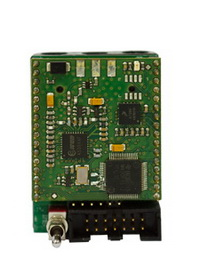 Freie Universitat Berlin Modular Sensor Board 430 with MSP430F1611, CC1020
Freie Universitat Berlin Modular Sensor Board 430 with MSP430F1611, CC1020
Kmote
- How Kmote started in India presentation
- Starter kit at TINYOS_MALL $300
- Mote Kmote-BR $60
BOOKS
Synopsis
Most used platform for Contiki is the combination of MSP430F1611 TI low power CPU + CC2430 TI 2.4GHz 802.15.4 RF chip. It is the best choice for minimum effort Contiki or TinyOS nodes
- Using above combination is the easiest way to go with Contiki as it is the most tested and is the 'official' chipset.
- MSP430 family is very friendly to work with and has the best Low-Power characteristics than any other CPU family.
- CC2430 is used by the open source Contiki and TinyOS more than other RF-chips. But there is not a low cost board available.
- The MSP430 + CC2430 available boards are also expensive, starting at $85
ATmega128RFA1 CPU+RF 2.4GHz 802.15.4 chip seems to be the best choice for a WSN platform (August 2011).
The technical characteristics are very good.
- Large Flash, RAM,EEPROM (128K,16K,2K)
- RF section has one of the best [reception-transmittion total gain]
- RF section is already used in the open source WSN-OS as it is the same with the Atmel RF chip RF230
- Commercial RF modules exist already at competitive pricing
- OpenHardware projects already exist
- Contiki port exists
- Atmel proprietary Zigbee stacks
- SYNAPSE ATmega128RFA1 based boards are the best engineered board regarding hardware, RF performance and Software.
- It is possible to use Contiki Software to Synapse ATmega128RFA1 boards (or any other ATmega128RFA1 board)
- It is already tested to use Synapse .HEX to other ATmega128RFA1 boards (Sparkfun board)
- Dresden has very good quality ATmega128RFA1 boards with all RF-approvals
- Sparkfun and Zigduino board are openhardware so can help in understanding and probably design a new board
- Atmel has good documentation and reference designs on how to design a ATmega128RFA1 board
- Synapse, Dresden, Sparkfun, Zigduino, Our-own design, can use all the same Software commercial or open-source
